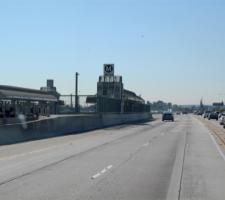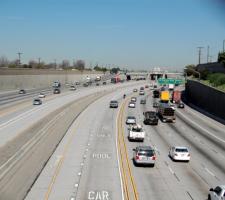
HOT lanes can add 10-15 per cent capacity to existing routes and also provide an option for dealing with the issues caused by longer-distance commutes.
The Big Apple's loss is the City of Angels's gain, according to Ken Philmus
The LA Express Lanes project is the largest single recipient of USDOT funding under the 2008 Urban Partnership Agreement. Some $210 million has been made available for converting existing carpool (HOV) lanes to HOT lanes on 14 miles of Interstate 10 (theA 12-month pilot is to look at whether the project in fact reduces congestion in the Los Angeles area and the outsider could be forgiven for writing it off is 'just another' HOT lane initiative. The reality, however, is quite different. Perhaps the biggest clue as to why, according to Ken Philmus, senior vice president and managing director transportation systems and services at
Another clue is in the name, he says: "LA Metro has made a deliberate decision to get away from the 'HOT Lane' image and name. It's going with 'Express Lanes' and great importance is attached to the use of the word 'express'. What sets the LA project apart from previous HOT lane-type projects is the sheer scale of the transit portion of the overall project. There's a very significant investment in transit stations and bus garages, as well as the transit vehicles themselves. The Express Lanes might be like typical HOT lanes in operation, and you can still buy into using them as a car-driver, but the intention is to underscore the linkages in the new system between multiple modes of transportation - particularly buses. Aligned with that big emphasis on transit is the aim of instilling the idea of the 'better-value commute' and part of the longer-range thinking is to find ways of expanding the multi-modal linkage between highways and transit."
A potential point of linkage is the TAP card project. The Transit Access Pass (TAP) card is a form of electronic ticketing used on public transport services within Los Angeles County. It is managed by LA Metro and is valid on a number of different travel systems in Los Angeles County including Metro Rail, Metro Bus, Metro Liner, City of Santa Clarita Transit, Culver City Bus, and Foothill Transit. More systems are planned to be added in the future. The card and fare collection systems are manufactured by
"I've long hoped that HOT lane operators would see an obvious transit link as most important to a programme's success," Philmus continues. "In the back office there is the potential, for instance, to provide incentives to HOT lane customers who've used transit regularly."
Learning from the past
The Los Angeles scheme is one of several which have emerged from the ashes of the cordon charging scheme proposed for New York City. That abortive undertaking, which failed at the local political stage despite the best efforts of former mayor Michael R. Bloomberg, also had a massive transit upgrade package associated with it."The New York project was very comprehensive but in the end there was too much legislative pressure from the city's outer boroughs and districts surrounding New York City," says Philmus. "That was doubly unfortunate given that only a very small percentage of people actually drive into the Manhattan Central Business District. But, unfortunately, local elected officials were unable to make that link.
"In Los Angeles, Chicago and the locations of the other new pilots there's a different attitude. What the cities have got is essentially free money and an opportunity to increase capacity - most managers of congested urban systems realise that either they can't expand their networks or else it is too expensive to do so. HOT lanes can add 10-15 per cent more space by converting existing HOV lanes.
"There's also geography to consider. Where New York City is very compact, Los Angeles is very much more spread out, with multiple business districts across the region, and there's also a very ingrained car culture. That would make a cordon charge very difficult to implement and manage."
Cutting cloth to suit
The debate over whether cordon/area congestion charging or the HOT lane approach is the way forward will rage on. Philmus thinks it is fitness for purpose rather than a blanket solution that should drive choices."I think it would be too much of a stretch to say that the Los Angeles Express Lanes project sets all the precedents, in that many of the existing HOT lane projects have been sold as having environmental benefits. Some people have asked whether the US would be better pursuing cordon charging as a philosophy. I'd turn that round and say there's equal merit in debating whether HOT lanes should be considered more fully in other parts of the world.
"There are very few cities in the US which are a natural fit for a cordon or area congestion charge.
Washington, DC, Chicago, San Francisco and New York all have adequate non-highway transit which would allow those who believe they are being priced out of cars to make choices at only the expense of a transit fare. There are other issues that we have to consider, however. Greece provides us with one. There, in protest at the current overall economic situation, citizens are actively not paying tolls right now. In reality, there's very little difference between that and, say, shoplifting but it shows the difference in attitude to paying tolls. It's a very interesting development.
"In the US, we've seen a long process of evolution from the all-cash tolling situation of the late 1980s via such things as E-ZPass and all-electronic toll collection. People tend to see car travel and roads as their absolute right but at least we have the advantage here that the gas tax is a direct tax. In Europe, so much of fuel revenue goes into the general taxation pot. That's a key difference.
"Tolls are becoming more popular in the US as the individual states and the federal government aren't willing to increase the gas tax - within 50 miles of New York City many major highways, bridges and tunnels are tolled, for instance. The HOT lane fee is a user fee, that's also important to note. The initial 'Lexus lane' image has diminished as the number of HOT lanes out there has grown. People see it as a time issue and HOT lanes as a reliever, not necessarily as an eliminator of congestion. The key point is that they're not just for the rich; if there's a straight choice between a $25 fine for being late to pick the kids up from nursery or a $3 road user fee, that's hardly a difficult choice. Slowly but surely we've seen things change over the last five to six years."
Packaged solutions
Now, he notes, policy-makers are talking about 'mobility' and whole packages of solutions. Quality of life is also being spoken of."Most Americans mind less about being stuck in traffic as long as they know how long they're going to be there," says Philmus. "But as things get worse attitudes are changing. More people are using transit than ever before because it's getting expensive to drive. It's taken too long for that to happen. In some parts of Europe people might be more accepting of transit or other modes such as walking or cycling but in the US people need to be coaxed and journeys made easier. I don't think artificially heightened fuel taxes are the only solution to attain that - selective and appropriate user fees really have an effective role
to play." "The US is building on what it has and taking steps to manage congestion but there's no doubt that we have a job on our hands. We've sprawled, no question. And where developers want to build, all too often they get the go-ahead if they pay for the construction of a new freeway exit. Often, that only creates more congestion in the long run. The nature of congestion has changed though; now a lot of journeys aren't suburb to city centre and back but suburb to suburb. At the same time, those making a 60 or 80-mile commute aren't going to want to use transit. HOT lanes really are an important part of the toolbox.
"Other evolutions are worth noting. We've started to see Smart cars, small town cars from Europe, appearing on roads in the US. That's an incredibly interesting cultural shift. As culture shifts, we have to have legislation track the changes. For instance, at the moment electric vehicles and hybrids often go free or at reduced rates on toll roads in general or on HOT lanes. That's good in the early stages of congestion management programmes as we look to lessen environmental impact but as such vehicles become more common it might become an unworkable policy because there are too many vehicles which will be using our roads without paying in some way for the wear and tear they cause. We have to accept that some of the philosophies which work well now may not later."
And yet more of the same...
That, he says, draws us back to the continuing lack of a national standard in the US for electronic toll collection."Once again, it's not the technology which holds us back but the politics and legislation. For example, since there are varying toll technologies around the US, DMVs should just not be able to walk away from sharing license plate information with other states for the purpose of toll or violation collection.. However, we're up against the dynamics of reality - states and elected officials are protective of their own constituents and are focused on taking positions to enhance electability. Once elected, positions may change. That doesn't always breed efficiency."













